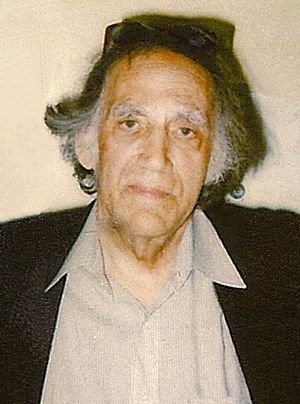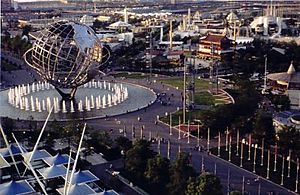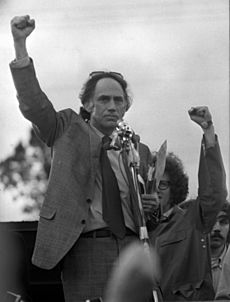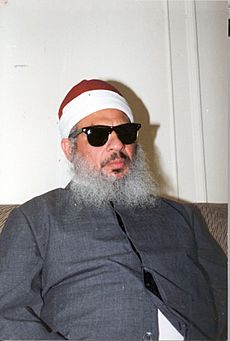William Kunstler facts for kids
Quick facts for kids
William Kunstler
|
|
|---|---|
 |
|
| Born |
William Moses Kunstler
July 7, 1919 New York City, U.S.
|
| Died | September 4, 1995 (aged 76) New York City, U.S.
|
| Education | Yale University (BA) Columbia University (LLB) |
| Occupation | Lawyer, civil rights activist |
| Spouse(s) | Lotte Kunstler Margaret Ratner |
| Children | 4, including Emily |
William Moses Kunstler (born July 7, 1919 – died September 4, 1995) was an American lawyer and activist. He was famous for defending people involved in important civil rights cases. Kunstler was a key member of groups like the National Lawyers Guild and the American Civil Liberties Union (ACLU). He also helped start the Center for Constitutional Rights (CCR).
Kunstler became very well known for defending the Chicago Seven in a big trial from 1969 to 1970. The New York Times newspaper even called him "the country's most controversial and, perhaps, its best-known lawyer." He also defended members of groups like the Black Panther Party and the American Indian Movement. He worked on cases involving the Attica Prison riot and helped challenge segregation in public schools.
William Kunstler was a figure who caused strong opinions. Some people on the right side of politics wanted him to stop practicing law. However, many on the left admired him as a symbol of a "radical lawyer." He was known for being good at talking to the press and getting his cases noticed.
Contents
Early Life and Education
William Kunstler was born in New York City to a Jewish family. His father, Monroe Bradford Kunstler, was a doctor. William went to DeWitt Clinton High School.
After high school, he studied French at Yale University. He graduated with high honors in 1941. Later, he went to Columbia Law School and finished in 1948. While at Yale, Kunstler enjoyed writing poetry.
Serving in World War II
Kunstler joined the U.S. Army during World War II. He served in the Pacific area and worked in cryptography, which involves secret codes. He became a Major and received the Bronze Star Medal for his service.
Starting His Law Career
After the war, Kunstler went to law school. He became a lawyer in New York in 1948. In the 1950s, he worked on family law and cases for small businesses. By the 1960s, he started focusing on civil rights cases. He also taught law at New York Law School for a short time.
In 1957, Kunstler received an award for his radio broadcasts called "The Law on Trial." On the radio, he also interviewed people about important topics on a show called Counterpoint.
Fighting for Civil Rights
Early Civil Rights Work (1957–1964)
Kunstler first gained attention in 1957. He defended William Worthy, a reporter whose passport was taken away. Worthy had visited Communist China, which the U.S. government did not allow. Kunstler argued that taking the passport was against the law.
In the 1960s, Kunstler became a very important civil rights lawyer. He traveled to many places in the South where segregation was common. He worked to help people who were arrested for protesting.
In 1961, he defended the Freedom Riders in Mississippi. These activists rode buses into segregated areas to challenge unfair laws. Kunstler tried to get them released from jail. He argued that the courts were unfair to African-American jurors.
In 1962, Kunstler helped efforts to open public parks and libraries to everyone in Albany, Georgia. He also wrote a book called The Case for Courage. This book told stories of lawyers and public servants who took risks to help people.
In 1963, Kunstler worked to move cases of arrested African-American protesters from local courts to federal courts. This was to challenge unfair local laws. He also sued housing authorities in Westchester County to fight against discrimination.
In 1964, Kunstler defended people accused of serious crimes. He successfully argued that some evidence should not be used in court. That same year, he challenged unfair election laws in Mississippi. He also defended members of a Harlem gang accused of murder.
Kunstler went to St. Augustine, Florida in 1964 during important protests led by Dr. Martin Luther King Jr.. These protests helped push Congress to pass the Civil Rights Act of 1964. Kunstler brought the first federal case under this new law. He defended protesters at the 1964 New York World's Fair.
Leading Civil Rights Organizations (1964–1972)
From 1964 to 1972, Kunstler was a director of the American Civil Liberties Union (ACLU). In 1966, he helped create the Center for Constitutional Rights. He also worked closely with the National Lawyers Guild, another group of lawyers focused on civil rights.
In 1965, Kunstler was asked to defend Jack Ruby, the man who shot Lee Harvey Oswald. Kunstler later dropped the case. In 1966, he defended a person accused of setting fire to a building. He argued that the person's confession was not valid because they did not have a lawyer.
Kunstler defended many other famous clients. These included H. Rap Brown, Stokely Carmichael, Angela Davis, and Martin Luther King Jr..
The Chicago Seven Trial (1969–1972)
Kunstler became nationally famous for defending the Chicago Seven. This was a group of activists accused of planning riots in Chicago during the 1968 Democratic National Convention. The trial lasted five months, from 1969 to 1970.
During the trial, Kunstler often argued with the prosecutor and the judge. He used the trial to highlight the strong feelings against the Vietnam War. For example, he asked singer Judy Collins to sing "Where Have All The Flowers Gone" from the witness stand. He also placed a Viet Cong flag on the defense table.
Kunstler showed that some police witnesses were not telling the truth. He also revealed that a prosecution witness was secretly working for the FBI. The trial was often dramatic and was covered on nightly news. This made Kunstler a well-known lawyer and a hero to many.
The jury found all seven defendants not guilty of planning a conspiracy. However, five were found guilty of violating anti-riot laws. Later, a higher court overturned all the convictions in 1972. The court said the judge had not allowed defense lawyers to properly question potential jurors about their biases. The government decided not to retry the case.
Defending Native American Rights (1973–1976)
In 1973, Kunstler went to Pine Ridge, South Dakota. He helped members of the American Indian Movement (AIM) who were involved in the Wounded Knee incident. Kunstler led their defense, calling it "the most important Indian trial of the 20th century." He tried to base the defense on the Treaty of Fort Laramie (1868). He represented AIM leaders Russell Means and Dennis Banks.
Kunstler argued that the heavy security in the courtroom could make the jury biased. The judge agreed to reduce the security. The trial was moved to Minnesota. Kunstler's team called authors and Sioux people to testify about the history of injustice against the Sioux by the U.S. government.
In 1975, Kunstler again defended AIM members. They were accused of killing two FBI agents near the Wounded Knee site. In the 1976 trial, Kunstler tried to get government officials to testify about a secret program against Native American activists.
Working with Ron Kuby and Other Cases
Partnership with Ron Kuby (1983–1995)
From 1983 until his death in 1995, Kunstler worked with his law partner, Ron Kuby. Together, they took on many challenging civil rights and criminal cases.
During the first Gulf War, they represented American soldiers who refused to fight. These soldiers claimed they were conscientious objectors, meaning their beliefs prevented them from participating in war.
Other Important Cases
In 1989 and 1990, Kunstler successfully argued in front of the Supreme Court twice. He defended the act of flag burning. In the cases Texas v. Johnson and United States v. Eichman, the Court ruled that flag burning is a form of protected speech under the First Amendment. This meant that laws against "flag desecration" were unconstitutional.
Kunstler also appeared in movies and TV shows. He played a lawyer in the movie The Doors (1991) and a judge in Malcolm X (1992). He also appeared as himself in several TV documentaries.
In 1993, Kunstler represented Yusuf Saalam, one of the Central Park 5. He worked on Saalam's appeal. Years after Kunstler's death, Saalam was proven innocent when another person confessed to the crime.
Later Life and Legacy
William Kunstler passed away in New York City in late 1995 from heart failure. He was 76 years old. In one of his last public speeches, he strongly spoke out against the death penalty.
Ron Kuby, his law partner, gave a speech remembering Kunstler. Kuby said that during the Chicago Seven trial, Kunstler "put the war in Vietnam on trial." He noted how Kunstler used music and symbols to make his point.
William Kunstler was survived by his wife, Margaret Ratner Kunstler, and his four daughters: Karin Kunstler Goldman, Jane Drazek, Sarah Kunstler, and Emily Kunstler.
His daughters, Emily and Sarah Kunstler, made a documentary film about their father. It is called William Kunstler: Disturbing the Universe. The film was shown at the 2009 Sundance Film Festival.
Images for kids








